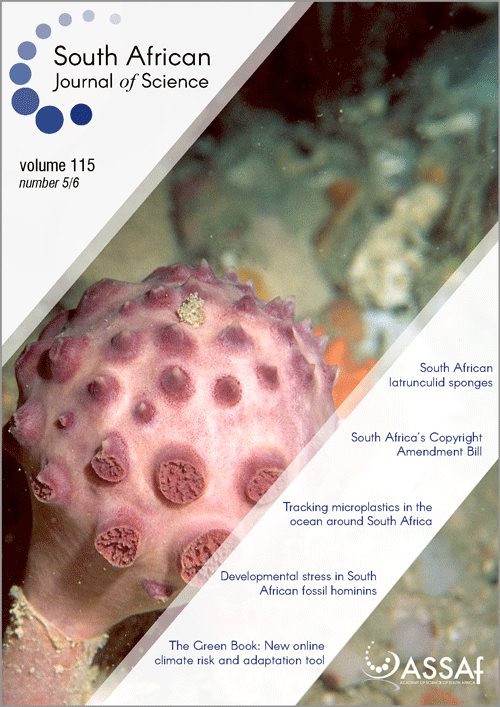Metatarsophalangeal proportions of Homo naledi
DOI:
https://doi.org/10.17159/sajs.2019/4662Keywords:
pedal proportions, resampling, Homo, phalanges, metatarsalsAbstract
Post-cranial differences between extant apes and humans include differences in the length, shape and size of bone elements relative to each other; i.e. differences in proportions. Foot proportions are influenced by the different functional requirements of climbing and bipedal locomotion. Phalangeal length is generally correlated with locomotor behaviour in primates and there is variation in hominins in relative phalangeal lengths – the functional and evolutionary significance of which is unclear and currently debated. Homo naledi has a largely modern rearfoot (i.e. tarsal skeleton) and midfoot (i.e. metatarsal skeleton). The proximal pedal phalanges of H. naledi are curved, but the relative lengths are unknown, because the phalanges cannot reliably be associated with metatarsals, or in many cases even with ray number. Here, we assess the lengths of the proximal pedal phalanges relative to the metatarsals in H. naledi with resampling from modern human and chimpanzee (Pan troglodytes) samples. We use a novel resampling method that employs two boundary conditions, assuming at one extreme that elements in the sample are associated, and at the other extreme that no elements are associated. The associated metatarsophalangeal proportions from digits 1 and 2 are within the 95% confidence interval of the modern human distribution. However, the associated and unassociated proportions from digits 3–5 fall above the 95% confidence interval of the human distribution, but below and outside of the chimpanzee distribution. While these results may indicate fossil preservation bias or other sample-derived statistical limitations, they potentially raise the intriguing possibility of unique medial versus lateral pedal column functional evolution in H. naledi. Additionally, the relevant associated proportions of H. naledi are compared to and are different from those of H. floresiensis. Both species suggest deep phylogenetic placement so the ancestral condition of the pedal phalanges in the genus Homo remains unclear.
Significance:
- Modern humans demonstrate straight and relatively short pedal phalanges, whereas H. naledi demonstrates curved phalanges of an unknown relative length. This research analyses the relative length of the proximal phalanges to the metatarsals to determine if naledi has relatively short phalanges similar to modern humans or is distinct from modern humans in both its phalangeal length and curvature.
- This analysis further develops a statistical resampling method that was previously applied to large fossil assemblages with little association between bones.
Published
Issue
Section
License

All articles are published under a Creative Commons Attribution 4.0 International Licence
Copyright is retained by the authors. Readers are welcome to reproduce, share and adapt the content without permission provided the source is attributed.
Disclaimer: The publisher and editors accept no responsibility for statements made by the authors
How to Cite
- Abstract 1364
- PDF 783
- EPUB 227
- XML 446












.png)